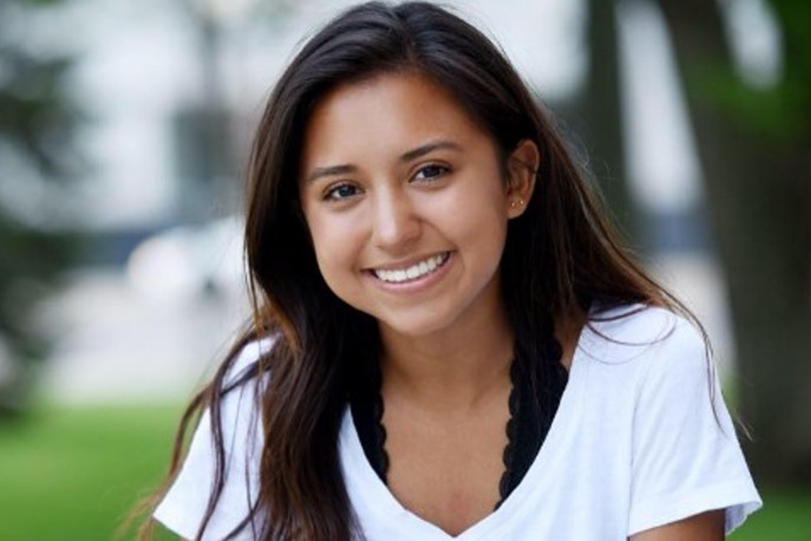An interview with Purdue SEEE president Ashley Sanchez
We recently sat down for a Q&A with Ashley Sanchez, a senior in Purdue Environmental and Ecological Engineering’s combined-degree program, which allows students to complete a B.S. and M.S. in just 5 years. Originally from Goshen, Indiana, Ashley is president of SEEE (Society of Environmental and Ecological Engineering), a member of Purdue’s Run Club, and won the 2021 Partners for Pollution Prevention Scholarship. Ashley is currently participating in undergraduate research on antimicrobial resistance in water, and she plans to focus her future career on water treatment and conservation. Her long-term goal is to work abroad for consulting firms that incorporate green infrastructure practices within stormwater management.

Q: Why did you choose Purdue EEE, and is there a topic that particularly interests you?
A: I’ve wanted to be an engineer since eighth grade. I chose Environmental and Ecological Engineering because I want to do impactful work that transcends me as an individual. I can’t be passionate about a major/career if I don’t believe I am making a difference. I was also drawn to the professor-to-student ratio of the program. I appreciate that each of my professors are willing to get to know me and make time for me. This sense of community has been significant in my growth as a student and a future engineer. Through various courses and work experience, I’ve grown specifically interested in water treatment and conservation. Our current water-management practices are not sustainable nationally or globally and we need new solutions.
Q: You won the 2021 Partners for Pollution Prevention Scholarship and subsequently attended their conference. Can you elaborate on that experience?
A: I was honored to receive the Partners for Pollution Prevention Scholarship and attending the conference was a great opportunity for professional development. The conference included a keynote speaker, awards presented to Indiana businesses conducting sustainability work, and lectures on water- or sustainability-related topics. There were also breaks during which I was able to network with other attendees.
Q: How has being a female and minority engineer made your experience at Purdue unique?
A: I don’t think that being a minority means I have to work harder than other students, but I have always felt that my academics and extracurricular activities have to be extraordinary to be noticed. I don’t see that as a set-back, however. It’s pushed me to join different organizations and find spaces where I can grow. Purdue has many organizations that have provided me with a sense of community. My freshman year, I was in the Women in Engineering Program (WIEP) learning community and was a part of Engineering Projects in Community Service (EPICS), a service-learning design program in which teams of students to partner with local and global community organizations. Once I chose Purdue EEE, the Society of Environmental and Ecological Engineering (SEEE) helped me to meet upper-class students and Purdue EEE alumni. I really benefited from their experience and advice. I decided to run for president of SEEE because I wanted to mentor and support incoming EEE students as they transitioned from COVID to in-person instruction.
Q: What Purdue EEE course did you enjoy the most thus far?
A: My favorite class was EEE 355: Engineering Environmental Sustainability with Professor Hua Cai, because it encompasses all of the reasons I chose Purdue EEE. The course covers environmental issues on a global scale and learning is very group-based. The final project was immersive and replicates what an engineer does at a professional level. I am currently an undergrad teaching assistant for the course under Dr. Larry Nies. I enjoy leading discussions on the instructional side in addition to participating in real-world projects through SEEE.
Q: Is there a particular faculty member in Purdue EEE who has inspired and/or supported you?
A: Professor Lindsey Payne has been a huge inspiration, not just as someone doing the type of work that I want to do, but as someone who embodies the type of human I want to be. Dr. Payne is a key environmental leader in the Greater Lafayette Area and her dedication to the local community makes her a wonderful role model. I have worked with Professor Payne on getting SEEE more involved in community service. A big part of being an environmental engineer is working with the public, since we design solutions not only for the environment, but for people.
Q: What advice would you give to a high school student about pursuing an education in engineering?
A: Use your first year to understand what each engineering major is really about. I had zero understanding of what a typical day looked like for engineers in each field or what types of projects they worked on professionally. Social norms make you believe that you should know exactly what you want to do for the rest of your life at the age of 18, and that you’ve failed in some way if you don’t. My advice is to take your time and learn what you love.
